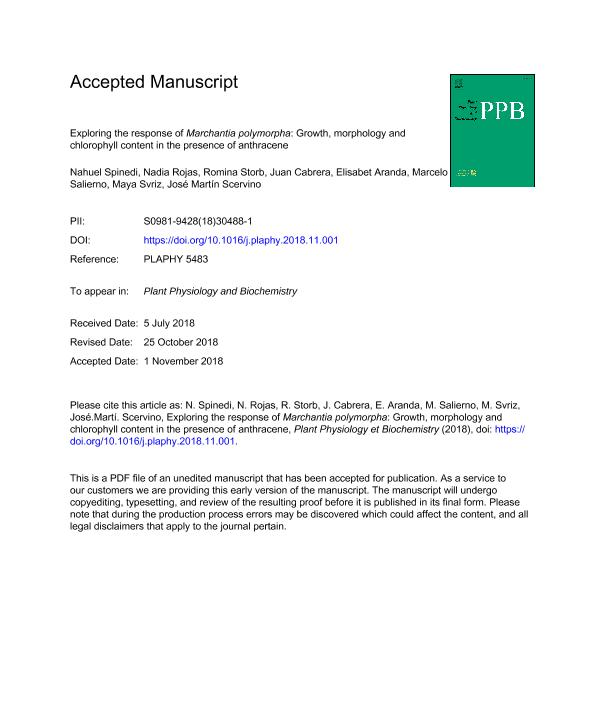Mostrar el registro sencillo del ítem
dc.contributor.author
Spinedi, Nahuel

dc.contributor.author
Rojas, Nadia Gimena

dc.contributor.author
Storb Guzman, Romina

dc.contributor.author
Cabrera, Juan Manuel

dc.contributor.author
Aranda, Elisabet

dc.contributor.author
Salierno, Marcelo Javier

dc.contributor.author
Svriz, Maya

dc.contributor.author
Scervino, Jose Martin

dc.date.available
2020-01-15T21:41:51Z
dc.date.issued
2019-02-03
dc.identifier.citation
Spinedi, Nahuel; Rojas, Nadia Gimena; Storb Guzman, Romina; Cabrera, Juan Manuel; Aranda, Elisabet; et al.; Exploring the response of Marchantia polymorpha: Growth, morphology and chlorophyll content in the presence of anthracene; Elsevier France-editions Scientifiques Medicales Elsevier; Plant Physiology and Biochemistry; 135; 3-2-2019; 570-574
dc.identifier.issn
0981-9428
dc.identifier.uri
http://hdl.handle.net/11336/94863
dc.description.abstract
Polycyclic aromatic hydrocarbons (PAHs) were identified as hazardous contaminants that are ubiquitous and persistent in aquatic environments, where bryophytes sensu lato (mosses, liverworts and hornworts) are frequently present. Marchantia polymorpha (Class Hepaticae; thalloid liverwort) is known to respond fast to changes in the environment; it accumulates toxic substances in its tissues due to the lack of vascular and radicular systems and a reduced or absent cuticle. The objective of the present study was to quantify the effects of increasing concentrations of anthracene (0, 50 100, 280 μM) on the germination of propagules, plant morphology and chlorophyll content index (CCI) in M. polymorpha under in vitro cultures. The results show that anthracene had no statistical effect on germination or propagula formation. However, plants exposed to anthracene for 30 days showed significantly lowered the content of chlorophyll (measured as CCI), irregular growth patterns and the induction of thalli asexual reproduction as evidenced by the production of multicellular viable propagules in gemmae cups. Results of epifluorescence microscopy also showed concomitant accumulation of anthracene in the cell walls. All of these distinctive morphological and physiological adaptive responses indicators, clearly suggest that M. polymorpha are capable of resisting high (coal tar) anthracene concentrations.
dc.format
application/pdf
dc.language.iso
eng
dc.publisher
Elsevier France-editions Scientifiques Medicales Elsevier

dc.rights
info:eu-repo/semantics/openAccess
dc.rights.uri
https://creativecommons.org/licenses/by-nc-nd/2.5/ar/
dc.subject
ANTHRACENE
dc.subject
BIOACCUMULATION
dc.subject
BIOINDICATOR
dc.subject
BRYOPHYTES
dc.subject
LIVERWORT
dc.subject
PHYTOTOXICITY
dc.subject.classification
Ciencias de las Plantas, Botánica

dc.subject.classification
Ciencias Biológicas

dc.subject.classification
CIENCIAS NATURALES Y EXACTAS

dc.title
Exploring the response of Marchantia polymorpha: Growth, morphology and chlorophyll content in the presence of anthracene
dc.type
info:eu-repo/semantics/article
dc.type
info:ar-repo/semantics/artículo
dc.type
info:eu-repo/semantics/publishedVersion
dc.date.updated
2019-10-10T13:57:52Z
dc.journal.volume
135
dc.journal.pagination
570-574
dc.journal.pais
Francia

dc.journal.ciudad
París
dc.description.fil
Fil: Spinedi, Nahuel. Consejo Nacional de Investigaciones Científicas y Técnicas. Centro Científico Tecnológico Conicet - Patagonia Norte. Instituto de Investigaciones en Biodiversidad y Medioambiente. Universidad Nacional del Comahue. Centro Regional Universidad Bariloche. Instituto de Investigaciones en Biodiversidad y Medioambiente; Argentina
dc.description.fil
Fil: Rojas, Nadia Gimena. Consejo Nacional de Investigaciones Científicas y Técnicas. Centro Científico Tecnológico Conicet - Patagonia Norte. Instituto de Investigaciones en Biodiversidad y Medioambiente. Universidad Nacional del Comahue. Centro Regional Universidad Bariloche. Instituto de Investigaciones en Biodiversidad y Medioambiente; Argentina
dc.description.fil
Fil: Storb Guzman, Romina. Consejo Nacional de Investigaciones Científicas y Técnicas. Centro Científico Tecnológico Conicet - Patagonia Norte. Instituto de Investigaciones en Biodiversidad y Medioambiente. Universidad Nacional del Comahue. Centro Regional Universidad Bariloche. Instituto de Investigaciones en Biodiversidad y Medioambiente; Argentina
dc.description.fil
Fil: Cabrera, Juan Manuel. Consejo Nacional de Investigaciones Científicas y Técnicas. Centro Científico Tecnológico Conicet - Patagonia Norte. Instituto de Investigaciones en Biodiversidad y Medioambiente. Universidad Nacional del Comahue. Centro Regional Universidad Bariloche. Instituto de Investigaciones en Biodiversidad y Medioambiente; Argentina
dc.description.fil
Fil: Aranda, Elisabet. Universidad de Granada; España
dc.description.fil
Fil: Salierno, Marcelo Javier. Consejo Nacional de Investigaciones Científicas y Técnicas. Centro Científico Tecnológico Conicet - Patagonia Norte. Instituto de Investigaciones en Biodiversidad y Medioambiente. Universidad Nacional del Comahue. Centro Regional Universidad Bariloche. Instituto de Investigaciones en Biodiversidad y Medioambiente; Argentina
dc.description.fil
Fil: Svriz, Maya. Consejo Nacional de Investigaciones Científicas y Técnicas. Centro Científico Tecnológico Conicet - Patagonia Norte; Argentina. Universidad Nacional de Río Negro; Argentina
dc.description.fil
Fil: Scervino, Jose Martin. Consejo Nacional de Investigaciones Científicas y Técnicas. Centro Científico Tecnológico Conicet - Patagonia Norte. Instituto de Investigaciones en Biodiversidad y Medioambiente. Universidad Nacional del Comahue. Centro Regional Universidad Bariloche. Instituto de Investigaciones en Biodiversidad y Medioambiente; Argentina
dc.journal.title
Plant Physiology and Biochemistry

dc.relation.alternativeid
info:eu-repo/semantics/altIdentifier/url/https://www.sciencedirect.com/science/article/abs/pii/S0981942818304881
dc.relation.alternativeid
info:eu-repo/semantics/altIdentifier/doi/http://dx.doi.org/10.1016/j.plaphy.2018.11.001
Archivos asociados
